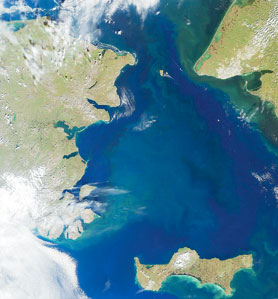
Bering Strait: the ancient passage is not submergedNASA/GSF/JPL/MISR TEAM
The work of three Brazilian geneticists and one Argentine anthropologist adds a little more controversy to a highly polemic subject: the process of population settlement in the Americas, the last continent to be taken over by Homo sapiens. According to the study, published last month in the online issue of the American Journal of Physical Anthropology, just one wave of migration from the north of Asia via the Bering Strait, some 18 thousand years ago, was sufficient to introduce all human biological diversity found in the Americas. The members of this primordial group of hunter-gatherers that penetrated the New World had a large variety of physical characteristics: from individuals who looked like the Mongoloid peoples, with oriental features (the forebears of all current native groups from the Americas), to those whose features were far less oriental (looking like the skull that was named Luzia, found in Lagoa Santa, state of Minas Gerais).
The new settlement model advocates the idea that before properly establishing themselves in the Americas, the earliest Asian immigrants remained stationary for thousands of years, probably some 18 thousand to 26 thousand years ago, in Beringia, a vast area of dry land linking Siberia and Alaska. The mandatory stop at this ancient point of contact between Asia and America (today Beringia is under water, giving rise to the Bering Strait), is not mere theoretical detail. While these people were stuck in this region, their DNA underwent changes. “There are mutations in the Amerindians that are specific to the time their forebears lived in Beringia which are not found among Asians,” says Maria Cátira Bortoloni, from the Federal University of Rio Grande do Sul (UFRGS), one of the study’s authors. When the glaciers closing entry to the Americas began melting, the remainder of the first group that had settled between the two continents finally entered the New World.
Based on the analysis of the anatomical features of 576 skulls of extinct and current peoples found throughout the Americas, and on 10 thousand samples of genetic data, the theory on the colonization of the Americas that the binational research team advocates, provides an interdisciplinary summary of knowledge about this thorny subject. “In the last 20 year there have been no integrated views on the settling of the Americas,” states Sandro Bonatto, from PUC-RS (the Catholic University of Rio Grande do Sul), another author of the study that was also signed by Fabricio Santos from UFMG (the Federal University of Minas Gerais) and by the Argentine Rolando González-José, from Centro Nacional Patagónico.
Perhaps this is why the new hypothesis differs from both the classical view and the other theses on the settlement of the Americas. The traditional theory talks about three waves of migration of Mongoloid peoples, of which the first allegedly occurred 12 thousand years ago. The model advocated by Walter Neves, from the University of São Paulo (USP), admits the existence of two migrations, one of individuals such as Luzia, 14 thousand years ago, and another more recent one, of Mongoloid groups. According to archeologist Niède Guidon, man reached the New World over 100 thousand years ago, probably via an Atlantic route.
Republish